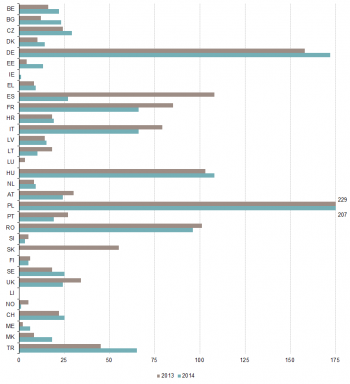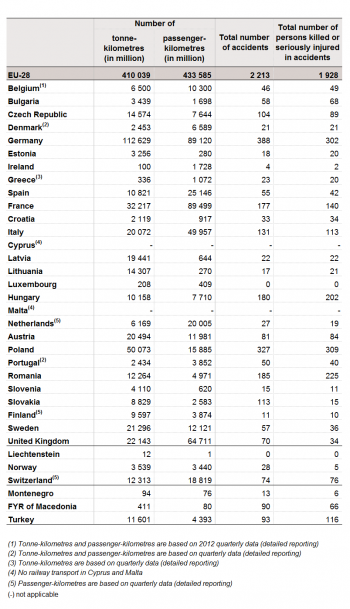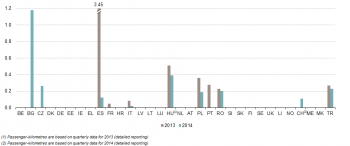Archive:Railway safety statistics
- Data from October 2015. Most recent data: Further Eurostat information, Main tables and Database. Planned update: November 2015
This article takes a look at recent annual statistics on rail transport accidents in the European Union (EU). Safety in rail transport has steadily enhanced over the years. However, in 2014, the number of accidents compared with 2013 showed an increase of 5.1 %. On the contrary, the number of victims (killed or injured persons) registered a large decrease over the same period (-9.5 %).

Source: Eurostat (rail_ac_catvict)
Main statistical findings

Source: Eurostat (rail_ac_catvict)

Source: Eurostat (rail_ac_catnmbr) (rail_ac_catvict) (rail_go_typeall) (rail_pa_total) (rail_go_quartal) (rail_pa_quartal)

Source: Eurostat (rail_ac_catvict) (rail_pa_total) (rail_pa_quartal)
In 2014, there were 1 928 persons killed or seriously injured in railway accidents in the EU-28, 9.5 % less than in 2013. Suicides are in principle excluded from these statistics, but not all Member States can identify them in the statistics sent to Eurostat.
A total of 2 213 significant train accidents were registered in the EU-28 in 2014, representing an increase of 5.1 % compared to 2013: this is an upturn compared with the regular declining trend observed since 2004.
Four Member States responsible for more than half of the victims in the EU-28
To measure the relative safety of rail transport, the number of accidents and the related number of victims have to be linked to traffic performance (expressed in passenger-kilometres and tonne-kilometres).
In absolute terms, Table 2 shows that four countries accounted for more than half of all rail victims registered in the EU-28 in 2014, namely Poland, Germany, Hungary and Romania. When considering the average number of persons killed or injured per accident, the ratio is lower than 1.2 in all EU, EFTA countries and Candidate countries; the ratio at EU level being 0.9. The high rate observed in Spain (4.6) in 2013 is especially influenced by the major accident having occurred in Santiago de Compostela on 24 July 2013.
When analysing the relation between passenger transport performance and rail safety using the number of passengers killed per passenger-kilometre, two countries record ratios of ten times higher than the EU-28 average (0.03 passengers killed per billion passenger-kilometres). These Member States are Bulgaria (1.18) and Hungary (0.39). Out of the EFTA and Candidate countries, Switzerland and Turkey are the only countries registering a ratio different than 0, with 0.11 and 0.23 passengers killed per billion passenger-kilometres in 2014, respectively.
Luxembourg and Liechtenstein are the only countries for which no victim (killed or injured persons) was reported in 2014.
Two types of accident caused 99 % of fatalities
For all participating countries, the most common type of accident with victims relates to accidents caused by rolling stock in motion or to those happening at level-crossings. In 2014, these two categories represented 95.1 % of the total amount of victims and 98.9 % of the fatalities (Table 1).
Only a minority (12 %) of rail accident victims in the EU-28 were actually passengers travelling on trains or railway employees. The majority, the remaining 88 %, was constituted of ‘other persons’ (e.g.: level-crossing users or unauthorised persons on railway premises).
At country level, 207 fatalities were registered in Poland, 172 in Germany and 108 in Hungary (Table 3). For the three countries, the majority of fatalities were linked to accidents caused by ‘rolling stock in motion’ (79 % for Poland, 70 % for Germany and 81 % for Hungary) (Table 4).
Within the European Union, the highest share of fatalities due to collisions in the total number of fatalities was recorded in Spain (4 %), followed by France (2 %).
Low number of fatalities per billion passenger-kilometres
As the number of passengers killed in rail accidents is very low each year, it is important to keep in mind that one single accident - or even one single victim - can have a big impact when comparing countries or the annual number of passengers killed per billion passenger-kilometres.
Bulgaria registered the highest ratio in 2014 (1.18 passengers killed per billion passenger-kilometres) ahead of Hungary (0.39): all the other reporting countries recorded a ratio under 0.30 in 2014 (Figure 2). For a large majority of countries, this indicator improved or remained constant between 2013 and 2014. Only Bulgaria and Czech Republic showed this ratio increase in 2014 compared to 2013.
Data sources and availability
Data availability
The figures presented in this publication have been extracted from the Eurostat rail transport database on 05/11/2014. It includes statistics on rail accidents in the Member States, EFTA and Candidate countries, collected according to Regulation 91/2003. Please note that all accidents are significant accidents.
Country-specific notes - country characteristics of data availability
(see country codes)
- CY: No railway transport
- MT: No railway transport
Methodology
Table 2 and Figure 2: quarterly transport performance data have to be provided only by the railway undertakings covered by so called detailed reporting (transport performance above the thresholds set in the Regulation – 500 million tonne-km or 200 million passenger-km). Railway undertakings which are below the thresholds may be included either in the detailed reporting or in the simplified reporting. It means that quarterly transport performance figures do not include smaller undertakings under simplified reporting.
Definitions
Definitions presented here are those of the Regulation n°1192/2003 of 3 July 2003 amending Regulation No 91/2003 of the European Parliament and of the Council on rail transport statistics.
- Significant accident
Any accident involving at least one rail vehicle in motion, resulting in at least one killed or seriously injured person, or in significant damage to stock, track, other installations or environment, or extensive disruptions to traffic. Accidents in workshops, warehouses and depots are excluded.
- Significant damage to stock, track, other installations or environment
This means damage that is equivalent to EUR 150 000 or more.
- Serious injury accident
Any accident involving at least one rail vehicle in motion, resulting in at least one killed or seriously injured person. Accidents in workshops, warehouses and depots are excluded.
- Level crossing accident
Any accident at level crossings involving at least one railway vehicle and one or more road vehicles, other users of the road such as pedestrians or other objects temporarily present at or near the track.
- Accident to persons caused by rolling stock in motion
Any accident to one or more persons that are either hit by a railway vehicle or part of it or hit by an object detached from the vehicle. Persons that fall from railway vehicles are included, as well as persons that fall or are hit by loose objects when travelling on-board vehicles.
- Person killed (Fatality)
Any person killed immediately or dying within 30 days as a result of an accident, excluding suicides. It includes passengers, employees and others persons specified or unspecified person involved in a rail injury accident.
- Person seriously injured
Any person injured who was hospitalised for more than 24 hours as a result of an accident, excluding attempted suicides.
- Rail passenger
Any person, excluding members of the train crew, who makes a trip by rail. For accident statistics, passengers trying to embark/disembark onto/from a moving train are included.
- Others
As a category of victim, "others" includes, for example, level crossing users and trespassers.
Symbols
| : | not available |
| - | not applicable |
| 0 | actual zero or very negligible transport |
| c | confidential data |
Context
The content of this statistical article is based on data collected within the framework of the EU rail transport statistics Regulation 91/2003 on rail transport statistics.
The basic legal act was amended by Commission Regulation 1192/2003 on rail transport statistics.
See also
- Freight transport statistics - modal split
- Passenger transport statistics
- Railway freight transport statistics
- Railway passenger transport statistics - quarterly and annual data
- Transport accident statistics
Further Eurostat information
Publications
- All transport publications on line
- Strong recovery in rail freight transport performance in the first nine months of 2010 - Statistics in focus 10/2012
- The fall in rail freight transport performance slowed down towards the end of 2009 - Statistics in focus 11/2011
- Goods transport by rail declining by the end of 2008 - Statistics in focus 19/2010
- Railway passenger transport decreased slightly at the beginning of 2009 - Statistics in focus 15/2010
- Energy, transport and environment indicators - 2014 edition
Main tables
- Transport, see:
- Railway transport (t_rail)
- Rail transport of passengers (ttr00015)
Database
- Transport, see:
- Railway transport (rail)
- Railway transport measurement - passengers (rail_pa)
- Railway transport - accidents (rail_ac)
Dedicated section
Methodology / Metadata
Source data for tables and figures (MS Excel)
Other information
- Regulation 91/2003 of 16 December 2002 on rail transport statistics
- Regulation 1192/2003 of 3 July 2003 amending Regulation 91/2003 on rail transport statistics
- For more data and metadata on rail accidents, please also see:
- Rail accidents by type of accident (ERA data)
- Rail accidents statistics (ESMS metadata file — tran_sf_rail_esms)
- Note:
- On 27.11.2012 Eurostat signed a Memorandum of Understanding with the European Rail Agency (ERA) whose role has significantly increased in the recent years regarding rail accidents data reporting.
- See Commission Directive 2014/88 of 9 July 2014 amending Directive 2004/49/EC.

